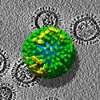An international team of scientists have discovered that the brain’s right parietal lobe is responsible for the disorder, dyscalculia, a kind of numerical dyslexia. The discovery made by researchers at University College London, University of the Negev, Israel, Birkbeck Centre for Brain and Cognitive Development, London, Maastricht University, Netherlands, and the Max Planck Institute for Brain Research, Germany, could ultimately lead to new methods of diagnosis and management of the disorder through remedial teaching.
Dyscalculia is as common as dyslexia and attention deficit hyperactivity disorder (ADHD) with about one in twenty people affected. However, dyscalculia has been given little regard in the mainstream despite its potentially debilitating impact on quality of life. Roi Cohen Kadosh, of UCL’s Institute of Cognitive Neuroscience explains the implications of his study, which involved inducing dyscalculia: “This is the first causal demonstration that the parietal lobe is the key to understanding developmental dyscalculia,” he explains, “Most people process numbers very easily — almost automatically — but people with dyscalculia do not.” The team stimulated for a few milliseconds the right parietal lobes of volunteers carrying out an arithmetic test, using neuronavigated transcranial magnetic stimulation (TMS) . The stimulation essentially knocked out activity in that part of the brain and left the volunteers unable to react as quickly to the test.
“This provides strong evidence that dyscalculia is caused by malformations in the right parietal lobe and provides sold grounds for further study on the physical abnormalities present in dyscalculics’ brains,” adds Cohen Kadosh, “It’s an important step to the ultimate goal of early diagnosis through analysis of neural tissue, which in turn will lead to earlier treatments and more effective remedial teaching.”
The researchers will publish details of their findings in the April 17 issue of the journal Current Biology
 Solid state NMR is unlocking the secrets of compounds found in natural membranes from frogs’ legs to human lungs that could lead to an entirely new class of antibiotic drugs. The compounds in question are antimicrobial peptides (AMPs) and they have been detected in every living creature studied so far. AMPs act as a first line chemical defence system in a huge range of organisms and could provide a novel approach to defeating drugs resistance in bacteria.
Solid state NMR is unlocking the secrets of compounds found in natural membranes from frogs’ legs to human lungs that could lead to an entirely new class of antibiotic drugs. The compounds in question are antimicrobial peptides (AMPs) and they have been detected in every living creature studied so far. AMPs act as a first line chemical defence system in a huge range of organisms and could provide a novel approach to defeating drugs resistance in bacteria. Both the UK and US national diabetes organizations have a risk test available for anyone worried about diabetes risk. Read the rest of this post and then take the tests and let me know how you get on.
Both the UK and US national diabetes organizations have a risk test available for anyone worried about diabetes risk. Read the rest of this post and then take the tests and let me know how you get on. Just £300,000 (about $600k) is being plugged into a national public debate by the UK government on stem cell research. According to Science and Innovation Minister Malcolm Wicks the UK’s two major public funders of stem cell research will use the cash to run a national public discussion about this cutting-edge area of science.
Just £300,000 (about $600k) is being plugged into a national public debate by the UK government on stem cell research. According to Science and Innovation Minister Malcolm Wicks the UK’s two major public funders of stem cell research will use the cash to run a national public discussion about this cutting-edge area of science. Could the contraceptive pill be replaced by a “natural” approach to family planning? It could if a study by Petra Frank-Herrmann of the Department of Gynaecological Endocrinology at the University of Heidelberg, Germany, proves reproducible (pardon the pun).
Could the contraceptive pill be replaced by a “natural” approach to family planning? It could if a study by Petra Frank-Herrmann of the Department of Gynaecological Endocrinology at the University of Heidelberg, Germany, proves reproducible (pardon the pun). “The US Food & Drug Administration’s (FDA) position on medical cannabis is incorrect, dishonest and a flagrant violation of laws requiring the government to base policy on sound science,” claims Joe Elford, Chief Counsel for patient advocacy group. The organisation, the largest of its type in the US promoting safe and legal access to cannabis for therapeutic use and research, has filed a lawsuit demanding that the federal government “cease issuing misinformation on medical cannabis and correct the information it has released.”
“The US Food & Drug Administration’s (FDA) position on medical cannabis is incorrect, dishonest and a flagrant violation of laws requiring the government to base policy on sound science,” claims Joe Elford, Chief Counsel for patient advocacy group. The organisation, the largest of its type in the US promoting safe and legal access to cannabis for therapeutic use and research, has filed a lawsuit demanding that the federal government “cease issuing misinformation on medical cannabis and correct the information it has released.” Bees making honey from honeydew rather than nectar produce a sweet material that has greater anti oxidant properties than nectar honey, according to a study of 36 honey samples from Spain with different floral origins. The study published this month in the Journal of the Science of Food and Agriculture could point to a way to improve the health benefits of this natural sweetener.
Bees making honey from honeydew rather than nectar produce a sweet material that has greater anti oxidant properties than nectar honey, according to a study of 36 honey samples from Spain with different floral origins. The study published this month in the Journal of the Science of Food and Agriculture could point to a way to improve the health benefits of this natural sweetener. If the avian influenza virus, H5N1, ever gets around to mutating into a lethal and virulent form that can be passed on readily from one person to another, then we will be facing a pandemic. Of course, as some observers have pointed out, mainly those without a vested interest in scaremongering, the process of mutation would more than likely lead to a strain of the disease that was not so commonly lethal in people, just as it is not commonly lethal in the natural wild bird hosts.
If the avian influenza virus, H5N1, ever gets around to mutating into a lethal and virulent form that can be passed on readily from one person to another, then we will be facing a pandemic. Of course, as some observers have pointed out, mainly those without a vested interest in scaremongering, the process of mutation would more than likely lead to a strain of the disease that was not so commonly lethal in people, just as it is not commonly lethal in the natural wild bird hosts.